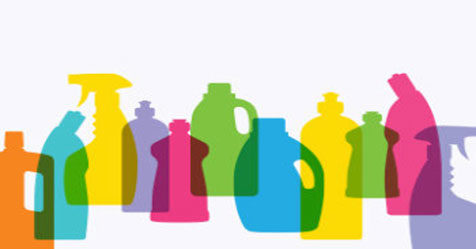I might want to use that again someday!
Most of us recognize the thought and how hanging on to unused items can impact our personal life, causing clutter, but also providing a sense of security. However, when it comes to chemicals used in custodial cleaning programs, developing a sentimental attachment to products and tools can be dangerous, unsustainable, and confusing.
Why is it important to reduce the number of chemicals in our operations? What can we do to fix it? How do we go about it? Here is a five-step action plan to help you consolidate your chemicals.
Step No. 1: Take Inventory
When I took over the custodial program for a government agency in the western part of the United States, I was amazed at how many chemicals there were on site—well over 100—and how there was no rhyme or reason to how they were stored. It was a big step forward to ask the custodians in each and every building to inventory the chemicals in their closets. They were to note how many of each product they had on site, the expiration dates of each, and how long it had been since they were last used.
Taking inventory of all products on site is the first step to streamlining your purchases. Once each custodian creates a list, compile them into one master list. Whether using electronic tablets, spreadsheets, or good old pen and paper, this step is the one that takes the most effort. Just keep your eye on the greater reward, improving public health and safety.
Step 2: Find a Toxic Waste Disposal Company
So many chemicals used in the past by custodial programs were extremely hazardous. If your program was like mine, you will have to dispose of a lot and you will want to do so responsibly. There are a number of large firms that handle hazardous waste; a search engine query should provide multiple companies in your area to investigate so that you can complete this step responsibly.
Step 3: Declutter and Simplify
If a chemical hasn’t been used in more than a year, chuck it—but in line with the previous step, make sure to do so responsibly. Before shipping off a load of hazardous waste, organize the products by type, whether chemicals are flammable, corrosive, reactive, toxic, or oxidizers. Be sure containers are sealed and safe for transport before sending them off for disposal.
As you decide which chemicals to keep, best practices should point toward low-environmental impact choices. Figure out the real needs and how one chemical can serve multiple purposes. Can your sanitizer also be a glass cleaner? Can your drain maintainer also work as odor control? How can you make things safer for your frontline workers?
Another way to cut down on products is to consider durables, such as microfiber mops and towels, perhaps even self-cleaning surfaces. Many managers are now adding touch-free restroom equipment, as well, which could help to cut down on soap and paper expenses, as these types of equipment can help standardize the dispensing of soap and paper towels. If your facility isn’t ready to make a move now, it would be a good time to at least consider it and at the very least, add some key items into your 5-year plan.
Step 4: Educate Staff
Now it’s time to reassure your team—remember, they may have just lost their favorite cleaners—that the new program works and makes their lives easier. Make sure they understand the new safety data sheets, pictographs, and warnings for each product (if there are any).
Demonstrate the effectiveness, increased safety, and ease of use of the new chemical program. Meaningful hands-on training is a must. Many equipment companies offer this training at low or no cost. This will help to ensure buy-in.
Step 5: Stay Progressive
Chemistry, as well as equipment in the jansan space, is not stagnant, and program managers shouldn’t be either. Engineered water is on the rise; can that fit into your strategy? How about a new green disinfectant with reduced kill time claims? It is one thing to have a scrubber machine that reaches into the corners, but how about high-touch self-cleaning surface protection? Keep up to date and informed on the progress happening in our industry.
In utilizing these five simple steps, you can reduce injury, increase staff productivity, reduce absenteeism, and help our ailing planet. After all, you will want to use your specially-selected items again—today, tomorrow, and the next day, too.




